中西方节日英文介绍
- 格式:doc
- 大小:22.50 KB
- 文档页数:2
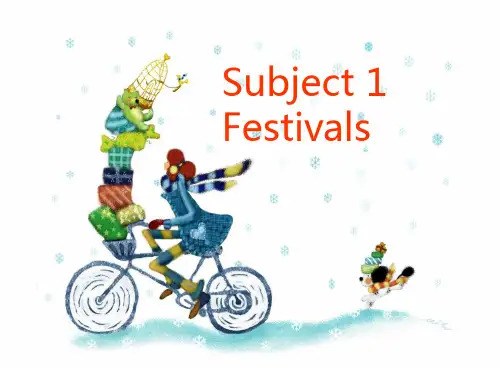
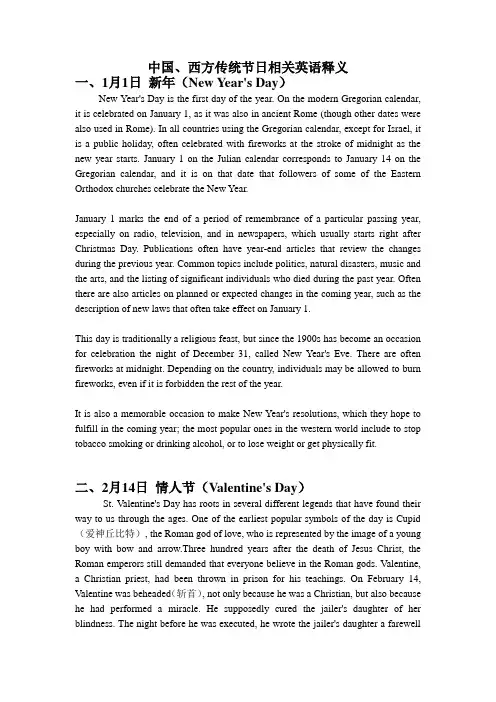
中国、西方传统节日相关英语释义一、1月1日新年(New Year's Day)New Year's Day is the first day of the year. On the modern Gregorian calendar, it is celebrated on January 1, as it was also in ancient Rome (though other dates were also used in Rome). In all countries using the Gregorian calendar, except for Israel, it is a public holiday, often celebrated with fireworks at the stroke of midnight as the new year starts. January 1 on the Julian calendar corresponds to January 14 on the Gregorian calendar, and it is on that date that followers of some of the Eastern Orthodox churches celebrate the New Year.January 1 marks the end of a period of remembrance of a particular passing year, especially on radio, television, and in newspapers, which usually starts right after Christmas Day. Publications often have year-end articles that review the changes during the previous year. Common topics include politics, natural disasters, music and the arts, and the listing of significant individuals who died during the past year. Often there are also articles on planned or expected changes in the coming year, such as the description of new laws that often take effect on January 1.This day is traditionally a religious feast, but since the 1900s has become an occasion for celebration the night of December 31, called New Year's Eve. There are often fireworks at midnight. Depending on the country, individuals may be allowed to burn fireworks, even if it is forbidden the rest of the year.It is also a memorable occasion to make New Year's resolutions, which they hope to fulfill in the coming year; the most popular ones in the western world include to stop tobacco smoking or drinking alcohol, or to lose weight or get physically fit.二、2月14日情人节(Valentine's Day)St. Valentine's Day has roots in several different legends that have found their way to us through the ages. One of the earliest popular symbols of the day is Cupid (爱神丘比特), the Roman god of love, who is represented by the image of a young boy with bow and arrow.Three hundred years after the death of Jesus Christ, the Roman emperors still demanded that everyone believe in the Roman gods. Valentine, a Christian priest, had been thrown in prison for his teachings. On February 14, Valentine was beheaded(斩首), not only because he was a Christian, but also because he had performed a miracle. He supposedly cured the jailer's daughter of her blindness. The night before he was executed, he wrote the jailer's daughter a farewellletter, signing it "From Your Valentine." Another legend tells us that this same Valentine, well-loved by all, received notes to his jail cell from children and friends who missed him.Another Valentine was an Italian bishop who lived at about the same time, AD 200. He was imprisoned because he secretly married couples, contrary to the laws of the Roman emperor. Some legends say he was burned at the stake.February 14 was also a Roman holiday, held in honor of a goddess. Young men randomly chose the name of a young girl to escort to the festivities. The custom of choosing a sweetheart on this date spread through Europe in the Middle Ages, and then to the early American colonies. Throughout the ages, people also believed that birds picked their mates on February 14!In AD 496 Sain Pope Gelasius I named February 14 as "Valentine's Day". Although it's not an official holiday, most Americans observe this day.Whatever the odd mixture of origins, St. Valentine's Day is now a day for sweethearts. It is the day that you show your friend or loved one that you care. You can send candy to someone you think is special. Or you can send roses, the flower of love. Most people send "valentines," a greeting card named after the notes that St. Valentine received in jail. Valentines can be sentimental, romantic and heartfelt(真心真意的). They can be funny and friendly. If the sender is shy, valentines can be anonymous.Americans of all ages love to send and receive valentines. Handmade valentines created by cutting hearts out of colored paper, show that a lot of thought was put into making them personal. Valentines can be heart-shaped, or have hearts, the symbol of love, on them. In elementary schools children make valentines for their classmates and put them in a large decorated box, similar to a mailbox. On February 14, the teacher opens the box and distributes the valentines to each student. After the students read their valentines they have a small party with refreshments.For teenagers and adults, major newspapers throughout the country have a Valentine's Day offer. Anyone can send in a message, for a small fee of course, destined for a would-be sweetheart, a good friend, an acquaintance or even a spouse of fifty years. The message is printed in a special section of the newspaper on February 14三、复活节(Easter)每年春分月圆之后第一个星期日The history of Easter 复活节的历史Since its conception as a holy celebration in the second century, Easter has had its non-religious side. In fact, Easter was originally a pagan festival.The ancient Saxons celebrated the return of spring with an uproarious festival commemorating their goddess of offspring and of springtime, Eastre. When the second-century Christian missionaries encountered the tribes of the north with their pagan celebrations, they attempted to convert them to Christianity. They did so, however, in a clandestine manner.It would have been suicide for the very early Christian converts to celebrate their holy days with observances that did not coincide with celebrations that already existed. To save lives, the missionaries cleverly decided to spread their religious message slowly throughout the populations by allowing them to continue to celebrate pagan feasts, but to do so in a Christian manner.As it happened, the pagan festival of Eastre occurred at the same time of year as the Christian observance of the Resurrection of Christ. It made sense, therefore, to alter the festival itself, to make it a Christian celebration as converts were slowly won over. The early name, Eastre, was eventually changed to its modern spelling, Easter.The Easter Egg 复活蛋As with the Easter Bunny and the holiday itself, the Easter Egg predates the Christian holiday of Easter. The exchange of eggs in the springtime is a custom that was centuries old when Easter was first celebrated by Christians.Today, children hunt colored eggs and place them in Easter baskets along with the modern version of real Easter eggs -- those made of plastic or chocolate candy.四、4月1日愚人节(April Fools' Day)Consider yourself warned. Sunday is April Fools' Day, a day when you are encouraged to pull pranks on loved ones, co-workers, casual acquaintances, and even that one guy at the bus stop. It's an odd tradition, but how did it get started? What's the history of April Fools' Day, anyway?Nobody is completely sure about the origin of this, the silliest of holidays. However the urban legend experts at say that most experts give credit to Pope Gregory XIII, who, in the 1500s, gave the world the Gregorian calendar.In 1562, the Gregorian calendar moved the first day of the year from April 1 to January 1. Word did eventually get around, but some people were a bit slow to hear the news. These folks continued celebrating the new year on April 1, unaware thatthey were now three months behind the times. These "April fools" were tricked by those in the know. The tradition eventually made its way to the USA.And it's still going strong. Over the past week, Web searches on "april fools day jokes" and "april fools day pranks" have more than doubled, and related lookups for "easy april fools day pranks" and "april fools day jokes for work" also spiked. Bottom line: Keep your guard up, especially if somebody offers you a word search puzzle. Lookups for "impossible april fools day word searches" are up 200%.But really, there is no way to be certain you'll escape trickery. Because on April 1, even corporations are out to trick you. In 1998, Burger King tricked its customers by releasing "the left-handed Whopper." In 1957, the BBC reported Swiss farmers were harvesting spaghetti from trees. And in 1996, Taco Bell took out ads in major newspapers announcing that the company had purchased the Liberty Bell and renamed it the Taco Liberty Bell. Shudder.(Agencies)五、5月的第二个星期日母亲节(Mother's Day)Jewish Proverb: God could not be everywhere and therefore be made mothers. Ancient celebrations of motherhoodRhea, Mother of the Greek godsPeople in many ancient cultures celebrated holidays honoring motherhood, personified as a goddess. Here are just a few of those:Ancient Greeks celebrated a holiday in honor of Rhea(Photo), the mother of the gods, including Zeus.Ancient Romans celebrated a holiday in honor of Cybele, a mother goddess.In the British Isles and Celtic Europe, the goddessBrigid(Photo), and later her successor St. Brigid, were honored with a spring Mother's Day.Motherhood honoured in modern timesMothers' Day is not celebrated on the same day throughout the world, for instance, in America Mother's Day occurs on the second Sunday in May while in Britain it is honored on the fourth Sunday in Lent(For more information on Lent, please check out Lent in "Easter's dictionary" or Carnival in "Word & Story").Mother's Day in Britainsimnel cake, a rich fruitcake sometimes covered with almond pasteMothering Sunday was celebrated in Britain beginning in the 17th century.It began as a day when apprentices and servants could return home for the day to visit their mothers. Traditionally, men went home with a gift of "mothering cake" -- a kind of fruitcake or fruit-filled pastry known as simnel cake (Photo ).Mother's Day in AmericaThanks to Anna M. Jarvis, Mother's Day has become an official holiday in the United States.After a year when her mother died on May 9, 1905, Anna M. Jarvis attended a memorial service at their church. Inspired by the service, she thought it would be wonderful if people set aside a time to pay personal tribute to their mothers. Then, the daughter began using some of her inheritance to promote a day that would honor all mothers.She and others staged a letter-writing campaign to ministers, businessmen, and politicians in their quest to establish a national Mother's Day. They were successful in the end. President Woodrow Wilson, in 1914, made the official announcement proclaiming Mother's Day a national observance that was to be held each year on the 2nd Sunday of May.Carnation: the symbol of Mother's DayIt was Jarvis who originated the custom of wearing a carnation on Mother's Day because carnation was her mother's favorite flower.A pink carnation is to honor a living mother and a white carnation is memory of a mother who passed away.六、6月的第三个星期日父亲节(Father's Day)Father's Day is a celebration of fathers inaugurated in the early twentieth century to complement Mother's Day in celebrating fatherhood and male parenting. Father's Day is celebrated on a variety of dates worldwide and typically involves gift-giving, special dinners to fathers, and family-oriented activities. The first observance of Father's Day actually took place in Fairmont, West Virginia on July 5, 1908. It was organized by Mrs. Grace Golden Clayton, who wanted to celebrate the lives of the 210 fathers who had been lost in the Monongah Mining disaster several months earlier in Monongah, West Virginia, on December 6, 1907. It is possible that Clayton was influenced by the first celebration of Mother's Day that same year, just a few miles away. Clayton chose the Sunday nearest to the birthday of her recently deceased father. Unfortunately, the day was overshadowed by other events in the city, West Virginia did not officially register the holiday, and it was not celebrated again. Instead, credit for Father's Day went to Sonora Dodd from Spokane, who invented independently her own celebration of Father's Day just two years later, also influenced by Jarvis' Mother's Day. Clayton's celebration was forgotten until 1972, when one of the attendants to the celebration saw Nixon's proclamation of Father's Day, and worked to recover its legacy. The celebration is now held every year in the CentralUnited Methodist Church, as the Williams Memorial Methodist Episcopal Church, South, was torn down in 1922. Fairmont is now promoted as the "Home of the First Father's Day Service".A bill to accord national recognition of the holiday was introduced in Congress in 1913. In 1916, President Woodrow Wilson went to Spokane to speak in a Father's Day celebration and wanted to make it official, but Congress resisted, fearing that it would become commercialized. US President Calvin Coolidge recommended in 1924 that the day be observed by the nation, but stopped short of issuing a national proclamation. Two earlier attempts to formally recognize the holiday had been defeated by Congress. In 1957, Maine Senator Margaret Chase Smith wrote a proposal accusing Congress of ignoring fathers for 40 years while honoring mothers, thus "[singling] out just one of our two parents".[4] In 1966, President Lyndon B. Johnson issued the first presidential proclamation honoring fathers, designating the third Sunday in June as Father's Day. Six years later, the day was made a permanent national holiday when President Richard Nixon signed it into law in 1972. In addition to Father's Day, International Men's Day is celebrated in many countries on November 19 for men and boys who are fathers.七、10月31日万圣节前夕(Halloween)The American tradition of "trick-or-treating" probably dates back to the early All Souls' Day parades in England. During the festivities, poor citizens would beg for food and families would give them pastries called "soul cakes" in return for their promise to pray for the family's dead relatives.The distribution of soul cakes was encouraged by the church as a way to replace the ancient practice of leaving food and wine for roaming spirits. The practice, which was referred to as "going a-souling" was eventually taken up by children who would visit the houses in their neighborhood and be given ale, food, and money.The tradition of dressing in costume for Halloween has both European and Celtic roots. Hundreds of years ago, winter was an uncertain and frightening time. Food supplies often ran low and, for the many people afraid of the dark, the short days of winter were full of constant worry. On Halloween, when it was believed that ghosts came back to the earthly world, people thought that they would encounter ghosts if they left their homes. To avoid being recognized by these ghosts, people would wear masks when they left their homes after dark so that the ghosts would mistake them for fellow spirits. On Halloween, to keep ghosts away from their houses, people would place bowls of food outside their homes to appease the ghosts and prevent them from attempting to enter.八、11月的第四个星期四感恩节(Thanksgiving Day)Story of American ThanksgivingThanksgiving Day is an American holiday and not celebrated in continental Europe. On the fourth Thursday of each November, families and friends gather together for the occasion to celebrate with a traditional turkey dinner, usually in the mid-afternoon. Thanksgiving originated as a celebration of the year's harvest and is similar to the Mid-Autumn Festival in China.The origin of the Thanksgiving Day感恩节的来历This American tradition started in 1621 before the United States of America was established. It was a huge celebration for a hard-earned harvest the first year after arriving in the New World.On September 6, 1620, the Mayflower ship set sail from Plymouth, Devon, England, taking all the English Pilgrims (清教徒)to the New World. The English Pilgrims numbered about a hundred people, and left England to escape religious persecution. Their voyage to the New World was financed by Merchant Adventurers, an English investor group.The Pilgrims sailed sixty-six days, arrived in the New World in November of the same year. They first settled in a cornfield abandoned by Native Indians and named it Plymouth Plantation.They worked on the land with much difficulty and were beset by a devastating plague in which half of the Pilgrim died in the long winter of 1620. In the spring of 1621, an Indian brave named Squanto and her Wampanoag (瓦帕浓人,北美印第安人阿尔琴族一部落)tribe came to their help. The tribe taught the Pilgrims how to work the earth and plant corn, beans, pumpkins, squash and other crops.The Thanksgiving feast in 1621In late September 1621, the Pilgrims were pleased with their great harvest. To celebrate their first harvest, the Pilgrims wanted to thank God and the Native Indian. They invited Squanto and the entire Wampanoag tribe that celebrate together in a shared feast.It was said about ninety Wampanoag turned up, much to the surprise of the Pilgrims, whose population had shrunk to no more than 50. The chief of the tribe had his men hunt five deer to bring to the feast. The first Thanksgiving dinner had an elaborate menu with venison, wild turkey, goose, duck, crane, swan, and other waterfowl; they also has local seafood: clams, lobsters, mussels, salmon, cod, bass, herring, shad, bluefish, lots of eel and oysters. They also cooked plenty of vegetables, among them squash, pumpkins and beans were the most popular.They ate raspberries, strawberries, grapes, plums, cherries, blueberries, walnuts,chestnuts, acorns, hickory and ground nuts, wheat flour, Indian corn and corn meal and they made beer out of barley. The pumpkin pudding was later developed into the traditional pumpkin pie.The first Thanksgiving dinner is said to have lasted from three days to one week with much food, beer and liquor. The Pilgrims and the Native Indian sat together on the ground, shared food with fingers or used rough plates made of wood or stale bread. They ran races, played oldEnglish games and staged parades during the festive, with marches, drums and firing of their muskets."Thanksgiving" related to the BibleThe phrase "thanksgiving" initially comes from the Bible. The Pilgrims of Plymouth, however, were mainly Puritans and strict Calvinist Protestants. They only observed three religious holidays from the New Testament: Sunday Sabbath, Days of Fasting and humiliation and Thanksgiving. Thanksgiving marked favourable ("mercies") in community life.The first Thanksgiving festival was indeed a time of happiness, fellowship and rejoicing for the Pilgrims. They arranged a friendly treaty with the Native American Indians, built houses in the wilderness, and raised sufficient crops to feed themselves for the upcoming long winter. The Pilgrims had become the first generation of settlers in this new land holding so much promise.From then on, Thanksgiving became a holiday for celebrating the harvest in the New World, dates varied from October to November each year over the next 150 years. Thanksgiving, the National holidayThe first National Thanksgiving was declared by the Continental Congress in 1777. On October 3, 1789, President George Washington declared that the people of the United States should observe "a day of public thanksgiving and prayer" on Thursday, 26 November.Many say the credit for the establishment of an annual Thanksgiving holiday should be given to Sarah Josepha Hale. Being the editor of Ladies Magazine and Godey's Lady's Book, she lobbied to the governors, senators, and presidents for a national holiday and published stories and recipes for that day in her magazine. After 36 years of crusading, she won her battle. In 1863, buoyed by the Union victory at Gettysburg, President Lincoln proclaimed that November 26, would be a national Thanksgiving Day, to be observed every year on the fourth Thursday of November.In 1941, a Congressional Joint Resolution set the fourth Thursday of November as a national holiday for Thanksgiving.There you are - the brief history of Thanksgiving- a day in America for families andfriends to gather together. The festival is also celebrated by Americans living abroad. Thanks to the Native Americans and the Pilgrims who created this idea of a day of Thanksgiving all those live in the New World can be thankful for all we have and share the joy with our family members and friends.九、12月25日圣诞节(Christmas Day)The history of Christmas dates back over 4000 years. Many of our Christmas traditions were celebrated centuries before the Christ child was born. The 12 days of Christmas, the bright fires, the yule log, the giving of gifts, carnivals(parades) with floats, carolers who sing while going from house to house, the holiday feasts, and the church processions can all be traced back to the early Mesopotamians.Many of these traditions began with the Mesopotamian (美索不达米亚) celebration of New Years. The Mesopotamians believed in many gods, and as their chief god - Marduk (马杜克,古代巴比伦人的主神,原为巴比伦的太阳神). Each year as winter arrived it was believed that Marduk would do battle with the monsters of chaos. To assist Marduk in his struggle the Mesopotamians held a festival for the New Year. This was Zagmuk, the New Year's festival that lasted for 12 days.The Mesopotamian king would return to the temple of Marduk and swear his faithfulness to the god. The traditions called for the king to die at the end of the year and to return with Marduk to battle at his side.To spare their king, the Mesopotamians used the idea of a "mock" king. A criminal was chosen and dressed in royal clothes. He was given all the respect and privileges of a real king. At the end of the celebration the "mock" king was stripped of the royal clothes and slain, sparing the life of the real king.The Roman's celebrated their god Saturn. Their festival was called Saturnalia which began the middle of December and ended January 1st. With cries of "Jo Saturnalia!" the celebration would include masquerades (化妆舞会) in the streets, big festive meals, visiting friends and the exchange of good-luck gifts called Strenae (lucky fruits)."Jo Saturnalia!" was a fun and festive time for the Romans, but the Christians though it an abomination (深恶痛绝) to honor the pagan (异教) god. The early Christians wanted to keep the birthday of their Christ child a solemn and religious holiday, not one of cheer and merriment as was the pagan Saturnalia.But as Christianity spread they were alarmed by the continuing celebration of pagan customs and Saturnalia among their converts. At first the Church forbid this kind of celebration. But it was to no avail (徒劳). Eventually it was decided that thecelebration would be tamed and made into a celebration fit for the Christian Son of God.Some legends claim that the Christian "Christmas" celebration was invented to compete against the pagan celebrations of December. The 25th was not only sacred to the Romans but also the Persians whose religion Mithraism (密特拉教,奉祀密特拉神的宗教,纪元后最初3世纪内传至罗马帝国) was one of Christianity's main rivals at that time. The Church eventually was successful in taking the merriment, lights, and gifts from the Saturanilia festival and bringing them to the celebration of Christmas一、除夕时间:农历一年最后一天,即十二月廿九或三十释义大年三十晚上叫除夕。
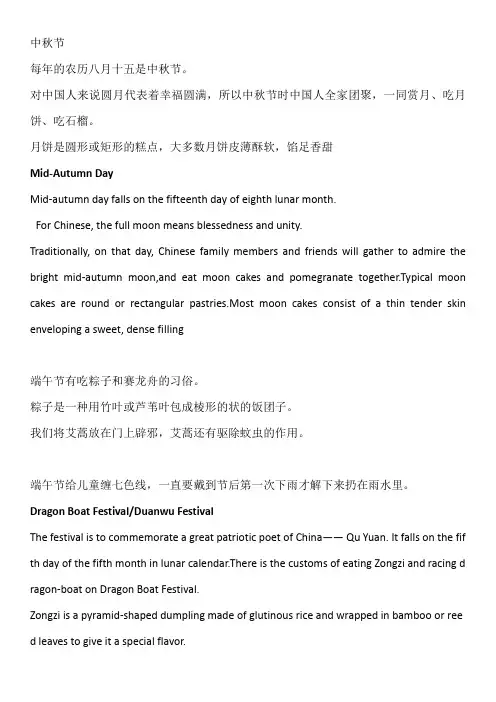
中秋节每年的农历八月十五是中秋节。
对中国人来说圆月代表着幸福圆满,所以中秋节时中国人全家团聚,一同赏月、吃月饼、吃石榴。
月饼是圆形或矩形的糕点,大多数月饼皮薄酥软,馅足香甜Mid-Autumn DayMid-autumn day falls on the fifteenth day of eighth lunar month.For Chinese, the full moon means blessedness and unity.Traditionally, on that day, Chinese family members and friends will gather to admire the bright mid-autumn moon,and eat moon cakes and pomegranate together.Typical moon cakes are round or rectangular pastries.Most moon cakes consist of a thin tender skin enveloping a sweet, dense filling端午节有吃粽子和赛龙舟的习俗。
粽子是一种用竹叶或芦苇叶包成棱形的状的饭团子。
我们将艾蒿放在门上辟邪,艾蒿还有驱除蚊虫的作用。
端午节给儿童缠七色线,一直要戴到节后第一次下雨才解下来扔在雨水里。
Dragon Boat Festival/Duanwu FestivalThe festival is to commemorate a great patriotic poet of China—— Qu Yuan. It falls on the fif th day of the fifth month in lunar calendar.There is the customs of eating Zongzi and racing d ragon-boat on Dragon Boat Festival.Zongzi is a pyramid-shaped dumpling made of glutinous rice and wrapped in bamboo or ree d leaves to give it a special flavor.We put mugwort on the door to ward off evil, and it has insect repellent function. Children wear bracelet made by seven colored strings until the first rain after the festival, they should throw the strings into puddle.对中国人来说,春节是最重要的节日。
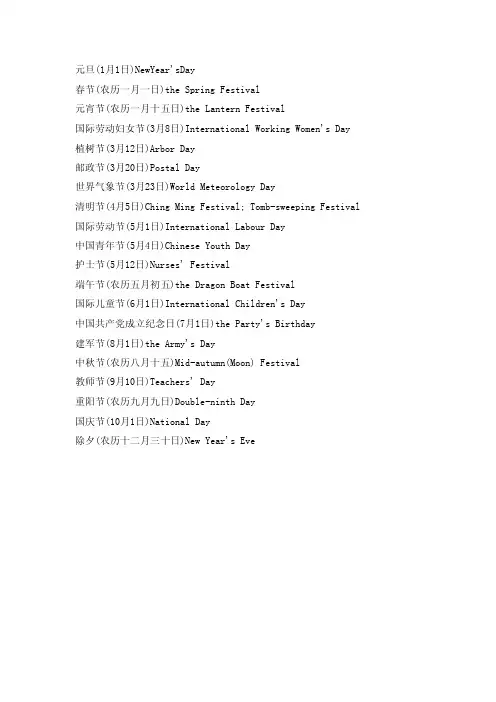
元旦(1月1日)NewYear'sDay春节(农历一月一日)the Spring Festival元宵节(农历一月十五日)the Lantern Festival国际劳动妇女节(3月8日)International Working Women's Day 植树节(3月12日)Arbor Day邮政节(3月20日)Postal Day世界气象节(3月23日)World Meteorology Day清明节(4月5日)Ching Ming Festival; Tomb-sweeping Festival 国际劳动节(5月1日)International Labour Day中国青年节(5月4日)Chinese Youth Day护士节(5月12日)Nurses' Festival端午节(农历五月初五)the Dragon Boat Festival国际儿童节(6月1日)International Children's Day中国共产党成立纪念日(7月1日)the Party's Birthday建军节(8月1日)the Army's Day中秋节(农历八月十五)Mid-autumn(Moon) Festival教师节(9月10日)Teachers' Day重阳节(农历九月九日)Double-ninth Day国庆节(10月1日)National Day除夕(农历十二月三十日)New Year's Eve1.Christmas 圣诞节每年12月25日,是基督教创始人耶稣的诞辰,也是基督徒最大的节日-圣诞节December 25th is Christmas Day on which Jesus Christ was born.It is the biggest day for the Christians.2.Valentine's Day 情人节在西方的一些国家中,有一个极富浪漫色彩,最受情侣们欢迎的节日,这就是每年2月14 句型的情人节。

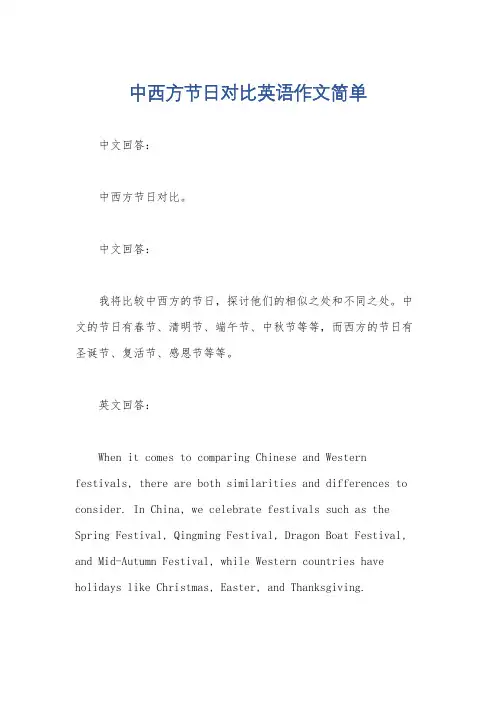
中西方节日对比英语作文简单中文回答:中西方节日对比。
中文回答:我将比较中西方的节日,探讨他们的相似之处和不同之处。
中文的节日有春节、清明节、端午节、中秋节等等,而西方的节日有圣诞节、复活节、感恩节等等。
英文回答:When it comes to comparing Chinese and Western festivals, there are both similarities and differences to consider. In China, we celebrate festivals such as the Spring Festival, Qingming Festival, Dragon Boat Festival, and Mid-Autumn Festival, while Western countries have holidays like Christmas, Easter, and Thanksgiving.中文回答:首先,中西方节日都是为了庆祝特定的事件或传统。
例如,春节是中国最重要的节日之一,它庆祝新年的开始,家人团聚,互赠红包和祝福。
类似地,圣诞节是西方国家最重要的节日之一,庆祝耶稣的诞生,人们会装饰圣诞树,交换礼物,与家人和朋友共度时光。
英文回答:Firstly, both Chinese and Western festivals are celebrated to mark specific events or traditions. For example, the Spring Festival is one of the most important festivals in China, celebrating the start of the new year with family reunions, red envelopes, and well wishes. Similarly, Christmas is one of the most significant holidays in Western countries, commemorating the birth of Jesus with the decoration of Christmas trees, exchanging gifts, and spending time with family and friends.中文回答:其次,中西方节日都有特定的食物和饮品与之相关联。
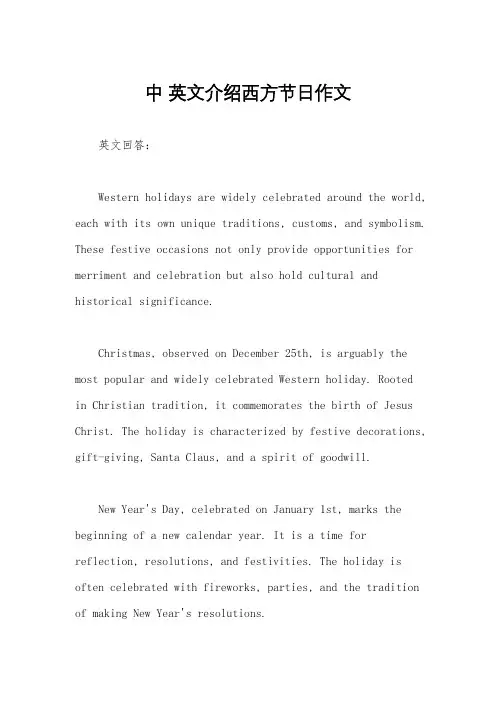
中英文介绍西方节日作文英文回答:Western holidays are widely celebrated around the world, each with its own unique traditions, customs, and symbolism. These festive occasions not only provide opportunities for merriment and celebration but also hold cultural and historical significance.Christmas, observed on December 25th, is arguably the most popular and widely celebrated Western holiday. Rootedin Christian tradition, it commemorates the birth of Jesus Christ. The holiday is characterized by festive decorations, gift-giving, Santa Claus, and a spirit of goodwill.New Year's Day, celebrated on January 1st, marks the beginning of a new calendar year. It is a time for reflection, resolutions, and festivities. The holiday is often celebrated with fireworks, parties, and the tradition of making New Year's resolutions.Valentine's Day, observed on February 14th, is dedicated to the expression of romantic love. It is a day for lovers to exchange gifts, chocolates, and cards. The holiday is typically associated with the color red, hearts, and the figure of Cupid.Easter, a movable feast that typically falls in March or April, is a Christian holiday that celebrates the resurrection of Jesus Christ. The holiday is marked by religious services, egg hunts, and the consumption of chocolate bunnies and eggs.Thanksgiving, observed in November, is a time for gratitude and reflection on the blessings of the past year. It is a harvest festival with a focus on family, feasting, and thanksgiving. The holiday is often celebrated with a traditional meal featuring turkey, stuffing, and pumpkin pie.These are just a few of the many Western holidays that are celebrated around the world. Each holiday has its ownunique traditions, customs, and symbolism, reflecting the diverse cultures and beliefs of the Western world.中文回答:西方节日在全球范围内广泛庆祝,每个节日都有其独特的传统、习俗和象征意义。
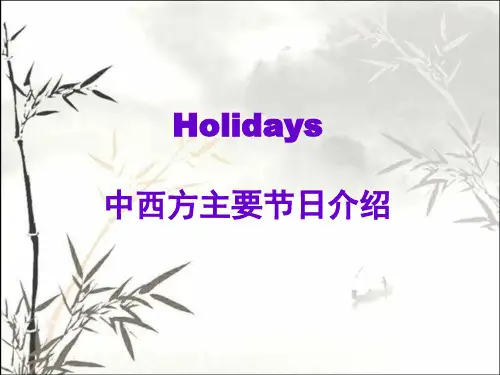
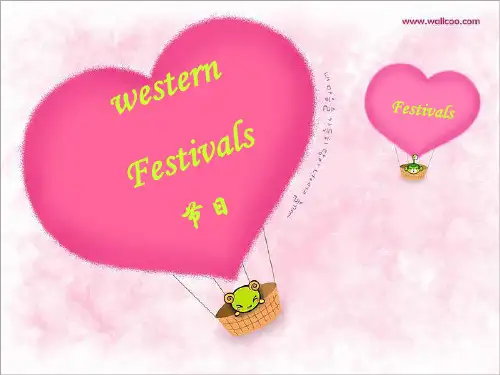
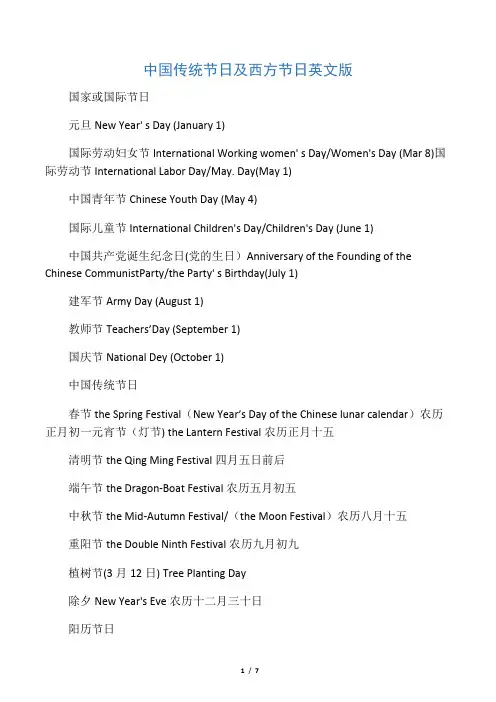
中国传统节日及西方节日英文版国家或国际节日元旦New Year' s Day (January 1)国际劳动妇女节International Working women' s Day/Women's Day (Mar 8)国际劳动节International Labor Day/May. Day(May 1)中国青年节Chinese Youth Day (May 4)国际儿童节International Children's Day/Children's Day (June 1)中国共产党诞生纪念日(党的生日)Anniversary of the Founding of the Chinese CommunistParty/the Party' s Birthday(July 1)建军节Army Day (August 1)教师节Teachers’Day (September 1)国庆节National Dey (October 1)中国传统节日春节the Spring Festival(New Year’s Day of the Chinese lunar calendar)农历正月初一元宵节(灯节) the Lantern Festival农历正月十五清明节the Qing Ming Festival四月五日前后端午节the Dragon-Boat Festival农历五月初五中秋节the Mid-Autumn Festival/(the Moon Festival)农历八月十五重阳节the Double Ninth Festival农历九月初九植树节(3月12日) Tree Planting Day除夕New Year's Eve农历十二月三十日阳历节日1月1日元旦(New Year's Day)2月2日世界湿地日(World Wetlands Day)2月14日情人节(Valentine's Day)3月3日全国爱耳日3月5日青年志愿者服务日3月8日国际妇女节(International Women' Day)3月9日保护母亲河日3月12日中国植树节(China Arbor Day)3月14日白色情人节(White Day)3月14日国际警察日(International Policemen' Day)3月15日世界消费者权益日(World Consumer Right Day)3月21日世界森林日(World Forest Day)3月21日世界睡眠日(World Sleep Day)3月22日世界水日(World Water Day)3月23日世界气象日(World Meteorological Day)3月24日世界防治结核病日(World Tuberculosis Day)4月1日愚人节(April Fools' Day)4月5日清明节(Tomb-sweeping Day)4月7日世界卫生日(World Health Day)4月22日世界地球日(World Earth Day)4月26日世界知识产权日(World Intellectual Property Day)5月1日国际劳动节(International Labour Day)5月3日世界哮喘日(World Asthma Day)5月4日中国青年节(Chinese Youth Day)15月8日世界红十字日(World Red-Cross Day)5月12日国际护士节(International Nurse Day)5月15日国际家庭日(International Family Day)5月17日世界电信日(World Telecommunications Day)5月20日全国学生营养日5月23日国际牛奶日(International Milk Day)5月31日世界无烟日(World No-Smoking Day)6月1日国际儿童节(International Children's Day)6月5日世界环境日(International Environment Day)6月6日全国爱眼日6月17日世界防治荒漠化和干旱日(World Day to combat desertification)6月23日国际奥林匹克日(International Olympic Day)6月25日全国土地日6月26日国际禁毒日(International Day Against Drug Abuse and Illicit Trafficking)7月1日中国共产党诞生日(Anniversary of the Founding of the Chinese Communist Party)7月1日国际建筑日(International Architecture Day)7月7日中国人民抗日战争纪念日7月11日世界人口日(World Population Day)8月1日中国人民解放军建军节(Army Day)8月12日国际青年节(International Youth Day)9月8日国际扫盲日(International Anti-illiteracy Day)9月10日中国教师节(Teacher's Day)9月16日中国脑健康日9月16日国际臭氧层保护日(International Day for the Preservation of the Ozone Layer)9月20日全国爱牙日9月21日世界停火日(World Cease-fire Day)9月27日世界旅游日(World Tourism Day)10月1日中华人民共和国国庆节(National Day)10月1日国际音乐日(International Music Day)10月1日国际老年人日(International Day of Older Persons)10月4日世界动物日(World Animal Day)10月5日世界教师日(World Teachers' Day)(联合国教科文组织确立)10月8日全国高血压日10月9日世界邮政日(World Post Day)10月10日世界精神卫生日(World Mental Health Day)10月14日世界标准日(World Standards Day)10月15日国际盲人节(International Day of the Blind)10月15日世界农村妇女日(World Rural Women's Day)10月16日世界粮食日(World Food Day)10月17日国际消除贫困日(International Day for the Eradication of Poverty)10月24日联合国日(United Nations Day)10月24日世界发展新闻日(World Development Information Day)10月28日中国男性健康日10月29日国际生物多样性日(International Biodiversity Day)10月31日万圣节(Halloween)11月8日中国记者节11月9日消防宣传日11月14日世界糖尿病日(World Diabetes Day)211月17日国际大学生节11月25日国际消除对妇女的暴力日(International Day For the elimination of Violence againstWomen)12月1日世界爱滋病日(World AIDS Day)12月3日世界残疾人日(World Disabled Day)12月4日全国法制宣传日12月9日世界足球日(World Football Day)12月25日圣诞节(Christmas Day)12月29日国际生物多样性日(International Biological Diversity Day)1月最后一个星期日国际麻风节3月最后一个完整周的星期一中小学生安全教育日春分月圆后的第一个星期日复活节(Easter Monday)(有可能是3月22-4月25日间的任一天)5月第二个星期日母亲节(Mother's Day)5月第三个星期日全国助残日6月第三个星期日父亲节(Father's Day)9月第三个星期二国际和平日(International Peace Day)9月第三个星期六全国国防教育日9月第四个星期日国际聋人节(International Day of the Deaf)10月的第一个星期一世界住房日(World Habitat Day)10月的第二个星斯一加拿大感恩节(Thanksgiving Day)10月第二个星期三国际减轻自然灾害日(International Day for Natural Disaster Reduction)10月第二个星期四世界爱眼日(World Sight Day)11月最后一个星期四美国感恩节(Thanksgiving Day)农历节日农历正月初一春节(the Spring Festival)农历正月十五元宵节(Lantern Festival)农历五月初五端午节(the Dragon-Boat Festival)农历七月初七乞巧节(中国情人节)(Double-Seventh Day)农历八月十五中秋节(the Mid-Autumn Festival)农历九月初九重阳节(the Double Ninth Festival)农历腊月初八腊八节(the laba Rice Porridge Festival) 农历腊月二十四传统扫房日3。
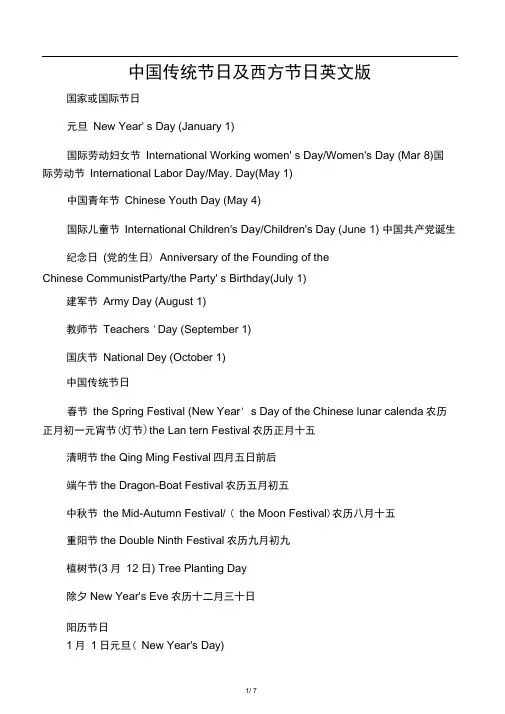
中国传统节日及西方节日英文版国家或国际节日元旦New Year' s Day (January 1)国际劳动妇女节International Working women' s Day/Women's Day (Mar 8)国际劳动节International Labor Day/May. Day(May 1)中国青年节Chinese Youth Day (May 4)国际儿童节International Children's Day/Children's Day (June 1) 中国共产党诞生纪念日(党的生日) Anniversary of the Founding of theChinese CommunistParty/the Party' s Birthday(July 1)建军节Army Day (August 1)教师节Teachers 'Day (September 1)国庆节National Dey (October 1)中国传统节日春节the Spring Festival (New Year' s Day of the Chinese lunar calenda农历正月初一元宵节(灯节)the Lan tern Festival农历正月十五清明节the Qing Ming Festival四月五日前后端午节the Dragon-Boat Festival农历五月初五中秋节the Mid-Autumn Festival/ ( the Moon Festival)农历八月十五重阳节the Double Ninth Festival农历九月初九植树节(3月12日) Tree Planting Day除夕New Year's Eve农历十二月三十日阳历节日1月1日元旦( New Year's Day)2月2日世界湿地日(World Wetlands Day)2 月14 日情人节(Valentine's Day)3月3日全国爱耳日3月5日青年志愿者服务日3月8日国际妇女节(International Women' Day)3月9日保护母亲河日3月12日中国植树节(China Arbor Day)3月14日白色情人节(White Day)3月14日国际警察日(International Policemen' Day)3月1 5日世界消费者权益日(World Consumer Right Day) 3 月21 日世界森林日( World Forest Day)3 月21 日世界睡眠日(World Sleep Day)3 月22日世界水日(World Water Day)3月23日世界气象日(World Meteorological Day)3 月24 日世界防治结核病日(World Tuberculosis Day)4月1 日愚人节(April Fools' Day)4 月5 日清明节( Tomb-sweeping Day)4月7日世界卫生日(World Health Day)4 月22日世界地球日(World Earth Day)4 月26日世界知识产权日(World Intellectual Property Day) 5月1日国际劳动节(International Labour Day)5月3日世界哮喘日(World Asthma Day)5月4日中国青年节( Chinese Youth Day)15月8日世界红十字日(World Red-Cross Day)5月12日国际护士节(International Nurse Day)5月15日国际家庭日(International Family Day)5月17日世界电信日(World Telecommunications Day)5月20日全国学生营养日5月23日国际牛奶日(International Milk Day)5月31日世界无烟日(World No-Smoking Day)6月1日国际儿童节(International Children's Day)6月5日世界环境日(International Environment Day)6月6日全国爱眼日6月17日世界防治荒漠化和干旱日(World Day to combat desertification)6月23日国际奥林匹克日(International Olympic Day)6月25日全国土地日6月26日国际禁毒日(International Day Against Drug Abuse and Illicit Trafficking)7月1日中国共产党诞生日(Anniversary of the Founding of the Chinese Communist Party)7月1 日国际建筑日(International Architecture Day)7月7日中国人民抗日战争纪念日7月11日世界人口日(World Population Day)8月1日中国人民解放军建军节(Army Day)8月12日国际青年节(International Youth Day)9月8日国际扫盲日(International Anti-illiteracy Day)9月10日中国教师节(Teacher's Day)9月16日中国脑健康日9月16日国际臭氧层保护日(International Day for the Preservation of the Ozone Layer)9月20日全国爱牙日9月21日世界停火日(World Cease-fire Day)9 月27日世界旅游日(World Tourism Day)10 月1 日中华人民共和国国庆节(National Day)10 月1 日国际音乐日(International Music Day)10 月1 日国际老年人日(International Day of Older Persons)10 月4 日世界动物日(World Animal Day)10月5日世界教师日(World Teachers' Day() 联合国教科文组织确立)10 月8 日全国高血压日10 月9 日世界邮政日(World Post Day)10 月10 日世界精神卫生日(World Mental Health Day)10 月14 日世界标准日(World Standards Day)10 月15 日国际盲人节(International Day of the Blind)10 月15 日世界农村妇女日(World Rural Women's Day)10 月16 日世界粮食日(World Food Day)10 月17 日国际消除贫困日(International Day for the Eradication of Poverty)10 月24 日联合国日(United Nations Day)10 月24 日世界发展新闻日(World Development Information Day)10 月28 日中国男性健康日10 月29 日国际生物多样性日(International Biodiversity Day)10 月31 日万圣节(Halloween)11月8日中国记者节11月9日消防宣传日11 月14 日世界糖尿病日(World Diabetes Day)211 月17 日国际大学生节11 月25 日国际消除对妇女的暴力日(International Day For the elimination of Violence againstWomen)12月1日世界爱滋病日(World AIDS Day)12 月3日世界残疾人日(World Disabled Day)12月4日全国法制宣传日12月9日世界足球日( World Football Day)12 月25 日圣诞节(Christmas Day)12 月29 日国际生物多样性日(International Biological Diversity Day)1 月最后一个星期日国际麻风节3 月最后一个完整周的星期一中小学生安全教育日春分月圆后的第一个星期日复活节(Easter Mon day)有可能是3月22-4月25 日间的任一天)5月第二个星期日母亲节(Mother's Day)5 月第三个星期日全国助残日6 月第三个星期日父亲节(Father's Day)9 月第三个星期二国际和平日(International Peace Day)9 月第三个星期六全国国防教育日9 月第四个星期日国际聋人节(International Day of the Deaf)10 月的第一个星期一世界住房日(World Habitat Day)10 月的第二个星斯一加拿大感恩节(Thanksgiving Day)10 月第二个星期三国际减轻自然灾害日(International Day for NaturalDisaster Reductio n)10 月第二个星期四世界爱眼日(World Sight Day)11 月最后一个星期四美国感恩节(Thanksgiving Day)农历节日农历正月初一春节(the Spring Festival)农历正月十五元宵节(Lantern Festival)农历五月初五端午节(the Dragon-Boat Festival)农历七月初七乞巧节(中国情人节) (Double-Seventh Day) 农历八月十五中秋节(the Mid-Autumn Festival) 农历九月初九重阳节(the Double Ninth Festival)农历腊月初八腊八节(the laba Rice Porridge Festival) 农历腊月二十四传统扫房日3。
中国传统节日及西方节日英文版国家或国际节日元旦New Year' s Day (January 1)国际劳动妇女节International Working women' s Day / Women's Day (Mar 8)国际劳动节International Labor Day / May. Day (May 1)中国青年节Chinese Youth Day (May 4)国际儿童节International Children's Day / Children's Day (June 1)中国共产党诞生纪念日( 党的生日)Anniversary of the Founding of the Chinese Communist Party / the Party' s Birthday (July 1)建军节Army Day (August 1)教师节Teachers’ Day (September 1)国庆节春节清明节端午节中秋节重阳节植树节(3除夕阳历节日1月12月22月143月33月53月83月93月123月143月143月153月213月213月223月23日世界气象日(World Meteorological Day)3月24日世界防治结核病日(World Tuberculosis Day)4月1日愚人节(April Fools' Day)4月5日清明节(Tomb-sweeping Day)4月7日世界卫生日(World Health Day)4月22日世界地球日(World Earth Day)4月26日世界知识产权日(World Intellectual Property Day)5月1日国际劳动节(International Labour Day)5月3日世界哮喘日(World Asthma Day)5月4日中国青年节(Chinese Youth Day)5月12日国际护士节(International Nurse Day)5月15日国际家庭日(International Family Day)5月17日世界电信日(World Telecommunications Day)5月20日全国学生营养日5月23日国际牛奶日(International Milk Day)5月31日世界无烟日(World No-Smoking Day)6月1日国际儿童节(International Children's Day)6月5日世界环境日(International Environment Day)6月6日全国爱眼日6月17日世界防治荒漠化和干旱日(World Day to combat desertification)6月23日国际奥林匹克日(International Olympic Day)6月25日全国土地日6月267月17月17月77月118月18月129月89月109月169月169月209月219月2710月110月110月110月410月510月810月910月1010月1410月1510月1510月1610月1710月24日联合国日(United Nations Day)10月24日世界发展新闻日(World Development Information Day)10月28日中国男性健康日10月29日国际生物多样性日(International Biodiversity Day)10月31日万圣节(Halloween)11月8日中国记者节11月9日消防宣传日11月14日世界糖尿病日(World Diabetes Day)11月17日国际大学生节11月25日国际消除对妇女的暴力日(International Day For the elimination of Violence against Women)12月3日世界残疾人日(World Disabled Day)12月4日全国法制宣传日12月9日世界足球日(World Football Day)12月25日圣诞节(Christmas Day)12月29日国际生物多样性日(International Biological Diversity Day)1月最后一个星期日国际麻风节3月最后一个完整周的星期一中小学生安全教育日春分月圆后的第一个星期日复活节(Easter Monday)(有可能是3月22-4月25日间的任一天) 5月第二个星期日母亲节(Mother's Day)5月第三个星期日全国助残日6月第三个星期日父亲节(Father's Day)9月第三个星期二国际和平日(International Peace Day)991010101011农历节日。
中西方传统节日英文介绍1. 春节(Chinese New Year)Chinese New Year, also known as Spring Festival, is the most important traditional festival in China. It is celebrated on the first day of the lunar new year and typically falls between January 21 and February 20. During the 15-day festival, people decorate their homes with red lanterns and couplets, eat festive foods, exchange red envelopes filled with money, and set off fireworks.2. 圣诞节(Christmas)Christmas is the holiday celebrating the birth of Jesus Christ, and it is widely celebrated in Western countries. It falls on December 25 and is typically marked by exchanging gifts, spending time with family, and attending church services. Christmas trees and decorations are also a popular part of the holiday.3. 感恩节(Thanksgiving)Thanksgiving is a holiday celebrated in the United States and Canada on the fourth Thursday in November. It is a day for giving thanks andcelebrating the blessings of the past year. Traditional food for the holiday includes turkey, stuffing, mashed potatoes, and pumpkin pie.4. 万圣节(Halloween)Halloween is a holiday celebrated on October 31, primarily in the US and Canada but also in other Western countries. It is a day for dressing up in costumes, decorating homes and neighborhoods with spooky decorations, and trick-or-treating for candy.5. 端午节(Dragon Boat Festival)The Dragon Boat Festival, also known as Duanwu Festival, is a traditional holiday in China that falls on the fifth day of the fifth lunar month, typically in June. The festival commemorates the death of Qu Yuan, a Chinese poet and politician who died over 2,000 years ago. On this day, people eat zongzi (sticky rice wrapped in bamboo leaves) and race dragon boats in memory of Qu Yuan.6. 复活节(Easter)Easter is a holiday celebrating the resurrection of Jesus Christ. It iscelebrated in Christian countries around the world and typically falls in March or April. The holiday is marked by attending church services, decorating eggs, and having Easter egg hunts. Easter bunnies and chocolate eggs are also popular symbols of the holiday.。
中西方传统节日的英文详细介绍阳历节日:1月1日元旦(NewYear'sDay)2月2日世界湿地日(WorldWetlandsDay)2月14日情人节(Valentine'sDay)3月8日国际妇女节(InternationalWomen'Day)3月12日中国植树节(ChinaArborDay)3月14日白色情人节(WhiteDay)3月14日国际警察日(InternationalPolicemen'Day)3月15日世界消费者权益日(WorldConsumerRightDay)3月21日世界森林日(WorldForestDay)3月21日世界睡眠日(WorldSleepDay)3月22日世界水日(WorldWaterDay)3月23日世界气象日(WorldMeteorologicalDay)3月24日世界防治结核病日(WorldTuberculosisDay)4月1日愚人节(AprilFools'Day)4月5日清明节(Tomb-sweepingDay)4月7日世界卫生日(WorldHealthDay)4月22日世界地球日(WorldEarthDay)4月26日世界知识产权日(WorldIntellectualPropertyDay)5月1日国际劳动节(InternationalLabourDay)5月4日中国青年节(ChineseYouthDay)5月8日世界红十字日(WorldRed-CrossDay)5月12日国际护士节(InternationalNurseDay)5月15日国际家庭日(InternationalFamilyDay)5月17日世界电信日(WorldTelecommunicationsDay5月31日世界无烟日(WorldNo-SmokingDay)6月1日国际儿童节(InternationalChildren'sDay)6月5日世界环境日(InternationalEnvironmentDay)6月17日世界防治荒漠化和干旱日(WorldDaytocombatdesertification)6月23日国际奥林匹克日(InternationalOlympicDay)6月26日国际禁毒日(InternationalDayAgainstDrugAbuseandIllicitTrafficking)7月1日中国建党日(AnniversaryoftheFoundingoftheChineseCommunistParty) 7月1日国际建筑日(InternationalArchitectureDay7月11日世界人口日(WorldPopulationDay)8月1日中国人民解放军建军节(ArmyDay)8月12日国际青年节(InternationalYouthDay)9月8日国际扫盲日(InternationalAnti-illiteracyDay)9月10日中国教师节(Teacher'sDay)9月16日国际臭氧层保护日(InternationalDayforthePreservationoftheOzoneLayer) 9月27日世界旅游日(WorldTourismDay)10月1日中华人民共和国国庆节(NationalDay)10月1日国际音乐日(InternationalMusicDay)10月1日国际老年人日(InternationalDayofOlderPersons)10月4日世界动物日(WorldAnimalDay)10月5日世界教师日(WorldTeachers'Day)(联合国教科文组织确立)10月9日世界邮政日(WorldPostDay)10月10日世界精神卫生日(WorldMentalHealthDay)10月15日国际盲人节(InternationalDayoftheBlind)10月15日世界农村妇女日(WorldRuralWomen'sDay)10月16日世界粮食日(WorldFoodDay)10月24日联合国日(UnitedNationsDay)10月24日世界发展新闻日(WorldDevelopmentInformationDay)10月31日万圣节(Halloween)12月1日世界爱滋病日(WorldAIDSDay)12月3日世界残疾人日(WorldDisabledDay)12月9日世界足球日(WorldFootballDay)12月25日圣诞节(ChristmasDay)春分月圆后的第一个星期日复活节(EasterMonday)(有可能是3月22-4月25日间的任一天) 5月第二个星期日母亲节(Mother'sDay)6月第三个星期日父亲节(Father'sDay)9月第三个星期二国际和平日(InternationalPeaceDay)9月第四个星期日国际聋人节(InternationalDayoftheDeaf)10月的第二个星斯一加拿大感恩节(ThanksgivingDay)11月最后一个星期四美国感恩节(ThanksgivingDay)农历正月初一春节(theSpringFestival)农历正月十五元宵节(LanternFestival)农历五月初五端午节(theDragon-BoatFestival)农历七月初七乞巧节(中国情人节)(Double-SeventhDay)农历八月十五中秋节(theMid-AutumnFestival)农历九月初九重阳节(theDoubleNinthFestival)农历腊月初八腊八节(thelabaRicePorridgeFestival)世界各国主要节日中英文对照第一部分、世界主要节日中英对照(按时间排序)元旦(1月1日)-----NEWYEAR’SDAY成人节(日本,1月15日)-----ADULTSDAY情人节(2月14日)-----ST.VALENTINE’SDAY(VALENTINE’SDAY)元宵节(阴历1月15日)-----LANTERNFESTIVAL狂欢节(巴西,二月中、下旬)-----CARNIVAL桃花节(日本女孩节,3月3日)-----PEACHFLOWERFESTIVAL(DOLL’SFESTIVAL)国际妇女节(3月8日)-----INTERNATIONALWOMEN’SDAY枫糖节(加拿大,3-4月)-----MAPLESUGARFESTIVAL愚人节(4月1日)-----FOOL’SDAY复活节(春分月圆后第一个星期日)-----EASTER宋干节(泰国新年4月13日)-----SONGKRANFESTIVALDAY国际劳动节(5月1日)-----INTERNATIONALLABOURDAY男孩节(日本,5月5日)-----BOY’SDAY母亲节(5月的第二个星期日)-----MOTHER’SDAY国际儿童节(6月1日)-----INTERNATIONALCHILDREN’SDAY父亲节(6月的第三个星期日)-----FATHER’SDAY端午节(阴历5月5日)-----DRAGONBOATFESTIVAL仲夏节(北欧6月)-----MID-SUMMERDAY中秋节(阴历8月15日)-----MOONFESTIVAL教师节(中国,9月10日)-----TEACHER’SDAY敬老节(日本,9月15日)-----OLDPEOPLE’SDAY(慕尼黑)啤酒节(德国十月节,10月10日)-----OKTOBERFEST(英国伦敦啤酒节、美国丹佛啤酒节和德国慕尼黑啤酒节)南瓜节(北美10月31日)-----PUMPKINDAY鬼节(万圣节除夕,10月31日夜)-----HALLOWEEN万圣节(11月1日)-----HALLOWMAS感恩节(美国,11月最后一个星期4)-----THANKSGIVING护士节(12月12日)-----NRUSEDAY圣诞除夕(12月24日)-----CHRISTMASEVE圣诞节(12月25日)-----CHRISTMASDAD新年除夕(12月31日)-----NEWYEAR’SEVE(abankholidayinmanycountries)春节(阴历一月一日)-----SPRINGFESTIVAL(CHINESENEWYEAR)第二部分、国际性节日世界消费者权益日(3月15日)-----WORLDCONSUMERRIGHTDAY 世界水日(3月22日)-----WORLDWATERDAY世界卫生日(4月7日)-----WORLDHEALTHDAY世界地球日(4月22日)-----WORLDEARTHDAY国际秘书节(4月25日)-----INTERNATIONALSECRETARYDAY国际红十字日(5月8日)-----INTERNATIONALRED-CROSSDAY国际护士节(5月12日)-----INTERNATIONALNURSEDAY世界电信日(5月17日)-----WORLDTELECOMMUNICATIONSDAY 世界无烟日(5月31日)-----WORLDNO-SMOKINGDAY世界环境日(6月5日)-----WORLDENVIRONMENTDAY世界人口日(7月11日)-----WORLDPOPULATIONDAY世界旅游日(9月27日)-----WORLDTOURISMDAY世界邮政日(10月9日)-----WORLDPOSTDAY世界粮食日(10月16日)-----WORLDGRAINDAY第三部分、世界各国的国庆与独立日一月1日古巴解放日----------LiberationDay(CUBA)苏丹独立日----------IndependenceDay(SUDAN)4日缅甸独立日----------IndependenceDay(MYANMAR)18日突尼斯革命日-------RevolutionDay(TUNIDIA)26日澳大利亚日----------AustraliaDay印度共和国日--------RepubicDay(INDIA)28日卢旺达民主日--------DemocracyDay(RWANDA)二月4日斯里兰卡国庆日-------NationalDay(SRILANKA)5日墨西哥宪法日---------ConstitutionDay(MEXICO)6日新西兰国庆日---------WaitangiDay(NEWZEALAND)7日格林纳达独立日-------IndependenceDay(GRENADA)11日日本建国日-----------NationalFoundingDay(JAPAN)伊朗伊斯兰革命胜利日-AnniversayoftheVictoryof theIslamicRevolution(IRAN)16日美国华盛顿诞辰-------Washington’sBirthday(USA)18日冈比亚独立日---------IndependenceDay(GAMBIA)23日文莱国庆日-----------NationalDay(BRUNEIDARUSSALAM) 圭亚那共和国日-------RepublicDay(GUIYANA)25日科威特国庆日---------NationalDay(KUWAIT)三月3日摩洛哥登基日---------EnthronementDay(MOROCCO)6日加纳独立日-----------IndependenceDay(CHANA)12日毛里求斯独立日-------IndependenceDay(MAURITHUS) 17日爱尔兰国庆日---------NationalDay(IRELAND)23日巴基斯坦日-----------PakistanDay25日希腊国庆日-----------NationalDay(GREECE)26日孟加拉独立及国庆日---Independence&NationalDay(BANGLADESH)31日马耳他国庆日---------NationalDay(MALTA)四月4日匈牙利国庆日---------LiberationDay(HUNGARY)塞内加尔独立日-------IndependenceDay(SENEGAL)11日乌干达解放日---------LiberationDay(UGANDA)16日丹麦女王日-----------BirthdayofHermajestyQueenMargretheⅡ(DENMARK) 17日叙利亚国庆日---------NationalDay(SYRIA)18日津巴布韦独立日-------IndependenceDay(ZIMBABWE)19日委内瑞拉独立节-------IndependenceDay(Venezuela)26日塞拉里昂共和国日-----RepublicDay(SIFRRALEONE)坦桑尼亚联合日-------UnionDay(TANZANIA)27日多哥独立日-----------IndependenceDay(TOGO)29日日本天皇诞辰---------BirthdayofHisMajestytheEmperor(JAPAN)30日荷兰女王日-----------Queen’sDay(THENETHERLANDS)五月9日捷克与斯洛伐克国庆日--NationalDay(CZECH&SLOYAKIA)17日挪威宪法日------------ConstitutionDay(NORWAY)20日喀麦隆国庆日----------NationalDay(CAMEROON)25日阿根廷5月革命纪念日---1810RevolutionDay(ARGENTINA)约旦独立日------------IndependenceDay(JORDAN)六月1日突尼斯胜利日----------VictoryDay(TUNISIA)西萨摩亚独立日--------IndependenceDay(WESTERNSAMOA)2日意大利共和国日--------FoundationofRepublic(ITALY)5日丹麦宪法日------------ConstitutionDay(DEMARK)塞舌尔解放日----------LiberationDay(SEYCHELLES)6日瑞典国庆日------------NationalDay(SWEDEN)7日乍得国庆日------------NationalDay(CHAD)10日葡萄牙国庆日----------National/PortugalDay(PORTUGAL)12日菲律宾独立日----------IndependenceDay(THEPHILIPPINES)14日英国女王官方生日-----OfficialBirthdayofHerMajestyQueenElizabethⅡ(UK) 17日冰岛共和国日----------AnniversaryoftheProclamationoftheRepublic (ICELAND)23日卢森堡国庆日----------NationalDay(LUXEMBOURG)24日西班牙国王陛下日------HisMajestytheKing’sDay(SPAIN)26日马达加斯加独立日------IndependenceDay(MADAGASCAR)27日吉布提独立日----------IndependenceDay(DJIBOUTI)七月1日布隆迪国庆日----------NationalDay(BURUNDI)加拿大日--------------CanadaDay卢望达独立日----------IndependenceDay(RWANDA)4日美国独立日------------IndependenceDay(USA)5日佛得角独立日----------IndependenceDay(CAPEVERDE)委内瑞纳独立日--------IndependenceDay(VENEZUELA)6日科摩罗独立日----------IndependenceDay(COMOROS)11日蒙古人民革命纪念日----AnniversaryofthePeople’sRevolution(MONGOLIA) 14日法国国庆日------------National/BastilleDay(FRANCE)17日伊拉克国庆日----------NationalDay(IRAQ)20日哥伦比亚国庆日--------NationalDay(COLOMBIA)21日比利时国庆日----------NationalDay(BELGIUM)22日波兰国家复兴节--------RebirthofPoland23日埃及国庆日------------NationalDay(EGYPT)26日利比利亚独立日--------IndependenceDay(LIBERIA)马尔代夫独立日--------IndependenceDay(MALDIVES)28日秘鲁独立日------------IndependenceDay(PERU)30日瓦努阿图独立日--------IndependenceDay(VANUATU)八月1日瑞士联邦成立日--------FoundationoftheConfederation(SWITZERLAND)4日布基纳法索国庆日------NationalDay(BURKINA-FASO)5日牙买加独立日----------IndependenceDay(JAMAICA)6日玻利维亚独立日--------IndependenceDay(BOLIVIA)10日厄瓜多尔独立日--------IndependenceDay(EQUADOR)15日刚国国庆日------------NationalDay(THEGONGO)17日加蓬独立日------------IndependenceDay(GABON)19日阿富汗独立日----------IndependenceDay(AFCHANISTAN) 23日罗马尼亚国庆日--------NationalDay(ROMANIA)31日马来西亚国庆日--------NationalDay(MALAYSIA)九月1日利比亚九月革命节------TheGreat1stofSeptember Revolution(LIBYA)2日越南国庆日------------NationalDay(VIETNAM)3日圣马力诺国庆日--------NationalDay(SANMARINO)7日巴西独立日------------IndependenceDay(BRAZIL)9日朝鲜共和国日----------DayoftheFoundingofDPPK12日佛得角国庆日----------NationalDay(CAPEVERDE)埃塞俄比亚人民革命日--Thepeople’sRevolutionDay(ETHIOPIA) 16日墨西哥独立节----------IndependenceDay(Mexico)18日智利独立日------------IndependenceDay(CHILE)22日马里宣布独立日--------ProclamationofIndependence(MALI) 30日博茨瓦纳独立日--------IndependenceDay(BOTSWANA)十月1日塞浦路斯国庆日--------NationalDay(CYPRUS)尼日利亚国庆日--------NationalDay(NIGERIA)2日几内亚宣布独立日------ProdclamationoftheRepublic(GUINEA) 9日乌干达独立日----------IndependenceDay(UGANDA)10日斐济国庆日------------NationalDay(FIJI)12日西班牙国庆日----------NationalDay(SPAIN)赤道几内牙国庆节------NationalDay(EquatorialGuinea)21日索马里十月革命节------21stOctoberRevolution(SOMALIA) 24日联合国日--------------UNDay赞比来独立日----------IndependenceDay(ZAMBIA)26日奥地利国庆日----------NationalDay(AUSTRIA)28日希腊国庆节------------NationalDay(Greece)29日土耳其共和国日--------ProdclamationoftheRepublic (TURKEY)十一月1日阿尔及里亚11月革命节--TheRevolutionDay(ALGERIA)11日安哥拉独立节----------IndependenceDay(Angola)15日比利时国王日----------King’sDay(BELGIUM)18日阿曼国庆日------------NationalDay(OMAN)19日摩纳哥国庆节----------NationalDay(Monaco)22日黎巴嫩独立日----------IndependenceDay(LEBANON)24日扎伊尔第二共和国日----AnniversaryoftheSecondRepublic(ZAIRE)28日毛里塔尼亚独立日------IndependenceDay(MARITANIA)29日南斯拉夫共和国日------RepublicDay(YUGOSLAVIA)十二月1日中非国庆日------------NationalDay(CENTRALAFRICA)2日老挝国庆日------------NationalDay(LAOS)阿拉伯酋长国国庆日----NationalDay(UAE)5日泰国国王日------------BirthdayAnniversaryofHisMajestyKingAdolyadej(THAILAND)6日芬兰独立日------------IndependenceDay(FINLAND)7日象牙海岸国庆日--------NationalDay(IVORYCOAST)12日肯尼亚独立日----------IndependenceDay(KENYA)17日不丹国庆节------------NationalDay(Bhutan)18日尼日尔国庆日----------NationalDay(NIGER)28日尼泊尔国王生日--------BirthdayofH.M.KingBirendara(NEPAL)---------------------------------------------------------------------------------------------------------------------------------------------------------------------------------世界各国节日一览表一、美国1.元旦节(NewYear'sDay),每年1月1日庆祝新的一年开始。
HalloweenOn October 31st, dozens of childrendressed in costumes (节日服装)knock on their neighbors' doors and yell "Trick or Treat" when the door opens. Pirates and princesses, ghosts and popular heroes of the day all hold bags open to catch the candy or othergoodies that the neighbors drop in. As they give each child a treat the neighbors exclaim over the costumes and try to guess who is under the masks.Since the 800's November 1st is a religious holiday known as All Saints' Day (万圣节). The Mass that was said on this day was called Allhallowmas. The evening before became knownas All Hakkiw e'en, or Halloween. Like some otherAmerican celebrations, its origins lie in both pre-Christian and Christian customs.October 31 st was the eve of the Celtic (凯尔特人的)new year. The Celts were the ancestors of the present-day Irish, Welsh and Scottish people. On this day ghosts walked and mingled with the living, or so the Celts thought. The townspeople baked food all that day and when night fell they dressed up and tried to resemble the souls of the dead. Hoping that the ghosts would leave peacefully before midnight of the new year.Much later, when Christianity spread throughout Ireland and October 31 was no longer the last dayof the year, Halloween became a celebration mostly for children. "Ghosts" went from door to door asking for treats, or else a trick would be played on the owners of the house. When millionsof Irish people immigrated to the United States in the 1840s the tradition came with them.Today' school dances and neighborhood parties called "block parties" are popular among young and old alike. More and more adults celebrate Halloween. They dress up like historical or political figures and go to masquerade parties (化妆舞会). In larger cities, costumed children and their parents gather at shopping malls early inthe evening. Stores and businesses give parties with games and treats for the children.Teenagers enjoy costume dances at their schools and the more outrageous the costume the better!Certain pranks (恶作剧)such as soaping car windows and tipping over garbage cans are expected. But partying and pranks are not the only things that Halloweeners enjoy doing. Some collect money to buy food and medicine for needychildren around the world.Symbols of HalloweenHalloween originated as a celebration connected with evil spirits. Witches flying on broomsticks with black cats, ghosts, goblins (小精灵)and skeletons have all evolved as symbolsof Halloween. They are popular trick-or-treat costumes and decorations for greeting cards and windows. Black is one of the traditional Halloween colors, probably because Halloween festivals and traditions took place at night. In the weeks before October 31, Americans decorate windows of houses and schools with silhouettes (轮廓)of witches and black cats.Pumpkins are also a symbol of Halloween. The pumpkin is an orange-colored squash, and orange has become the other traditional Halloween color. Carving pumpkins into jack- o'lanternsChinese V alentine's Day(七巧节)Raise your head on August 19 and gaze at the stars, you will find something romantic going on in the sky. V ALENTINE'S Day in China, the seventh day of the seventh lunar month, falls on August 19 this year. That is, on Sunday evening, Niu Lang and Zhi Nu will meet on a bridge of magpies(鹊桥)across the Milky Way(银河). Chinese grannies will remind children that they would not be able to see any magpies on that evening because all the magpies have left to form abridge in the heavens with their wings.Hungry Ghost Festival(中元节)The 14th and 15th of the seventh lunar monthUnlike other celebrations of the dead in Eastern cultures that seek to honor dead ancestors, the Hungry Ghost Festival seeks to pacify the hungry ghosts, the ghosts of strangers and the un-cared-for dead. These are the ghosts of those who died by their own hands, by accidents, by drowning or hanging who have been denied entry into heaven. Angry because they are forced to dwell in hell without food or comfort, when released, they search for souls to take their place in misery.The most important days of this month are the 14th and 15th, the days of the great feasts. On the 14th, a great feast would be held to honor family ancestors. Prayers and offerings would be made at family altars. On the following night, the 15th, they would feast for the hungry ghosts. Held outside under the full moon, these feasts feed the evil spirits so that they will leave the living alone and bribe(贿赂)the ancestors for luck with money and the harvest.Winter solstice(冬至)Winter solstice is a very important solar term in Chinese Lunar calendar.Being a traditional holiday as well, it is still now celebrated quite often in many regions. Early during the Spring and Autumn period, 2500 odd years from now, Winter solsticewas first determined as the Chinese traditional solar term among the total 24 terms. In Gregorian calendar, it is around Dec 22nd or 23rd.Ancient china did pay great attention to this holiday, regarding it as a big event. There was the saying that "Winter solstice holiday is greater than the spring festival". Nowadays, many regions still celebrate it as a big holiday. Northerners may have dumplings and raviolis that day while southerners may have dumplings made by rice and long noodles. Some places even have the tradition to offer sacrifices to the heaven and earth.Spring Festival(春节)The New Moon on the first day of the new year-- the full moon 15 days laterChinese New Y ear starts with the New Moon(新月)on the first day of the new year and ends on the full moon(满月)15 days later. The 15th day of the new year is called the Lantern Festival(元宵节), which is celebrated at night with lantern displays and children carrying lanterns in a parade.The Origin of Chinese New Y earThe Chinese New Y ear is now popularly known as the Spring Festival because it starts from the Begining of Spring (the first of the twenty-four terms in coodination with the changes of Nature). Its origin is too old to be traced. Several explanations are hanging around. All agree, however, that the word Nian, which in modern Chinese solely means "year", was originally the name of a monster beast that started to prey on people the night before the beginning of a new year. Traditional New Y ear FoodsProbably more food is consumed during the New Y ear celebrations than any other time of the year. V ast amounts of traditional food is prepared for family and friends, as well as those close to us who have died. On New Y ear's Day, the Chinese family will eat a vegetarian dish called jai. Although the various ingredients in jai are root vegetables or fibrous vegetables, many people attribute various superstitious aspects to them. Other foods include a whole fish, to represent togetherness and abundance, and a chicken for prosperity. The chicken must be presented with ahead, tail and feet to symbolize completeness. Noodles should be uncut, as they represent long life.In south China, the favorite and most typical dishes were nian gao, sweet steamed glutinous rice (糯米)pudding and zong zi (glutinous rice wrapped up in reed(芦苇)leaves), another popular delicacy. In the north, steamed-wheat bread (man tou) and small meat dumplings were the preferred food. The tremendous amount of food prepared at this time was meant to symbolize abundance and wealth for the household.Lantern Festival元宵The 15th day of the 1st lunar month is the Chinese Lantern Festival because the first lunar month is called yuan-month and in the ancient times people called night Xiao. The 15th day is the first night to see a full moon. So the day is also called Y uan Xiao Festival in China.According to the Chinese tradition, at the very beginning of a new year, when there is a bright full moon hanging in the sky, there should be thousands of colorful lanterns hung out for people to appreciate. At this time, people will try to solve the puzzles on the lanterns and eat yuanxiao (glutinous rice ball) and get all their families united in the joyful atmosphere.Besides entertainment and beautiful lanterns, another important part of the Lantern Festival,or Y uanxiao Festival is eating small dumpling balls made of glutinous rice flour. We call these balls Y uanxiao or Tangyuan. Obviously, they get the name from the festival itself. It is said that the custom of eating Y uanxiao originated during the Eastern Jin Dynasty in the fourth centuty, then became popular during the Tang and Song periods.The fillings inside the dumplings or Y uansiao are either sweet or salty. Sweet fillings are made of sugar, Walnuts(胡桃), sesame, osmanthus flowers(桂花), rose petals, sweetened tangerine peel, bean paste, or jujube paste(枣泥). A single ingredient or any combination can be used as the filling . The salty variety is filled with minced meat, vegetables or a mixture.The way to make Y uanxiao also varies between northern and southern China. The usual method followed in southern provinces is to shape the dough of rice flour into balls, make a hole, insert the filling, then close the hole and smooth out the dumpling by rolling it between your hands. In North China, sweet or nonmeat stuffing is the usual ingredient. The fillings are pressed into hardened cores, dipped lightly in water and rolled in a flat basket containing dry glutinous rice flour. A layer of the flour sticks to the filling, which is then again dipped in water and rolled a second time in the rice flour. And so it goes, like rolling a snowball, until the dumpling is the desired size.The custom of eating Y uanxiao dumplings remains. This tradition encourages both old and new stores to promote their Y uanxiao products. They all try their best to improve the taste and quality of the dumplings to attract more customers.Qing Ming(Tomb Sweeping Day)Celebrated two weeks after the vernal equinox, Tomb Sweeping Day is one of the few traditional Chinese holidays that follows the solar calendar-- typically falling on April 4, 5, or 6. Its Chinese name "Qing Ming" literally means "Clear Brightness," hinting at its importance as a celebration of Spring. Similar to the spring festivals of other cultures, Tomb Sweeping Day celebrates the rebirth of nature, while marking the beginning of the planting season and other outdoor activities. EasterEaster is a Christian holiday celebrating the resurrection of Christ. Now for most people, Easter is a good time to enjoy the festival. Time is the first full moon after the vernal equinox on Sunday,probably in the March 22-April 25 any day between. Easter gift with a typical spring and regeneration, such as eggs, Easter Bunny, etc.. Easter morning, children will find the bed of the Easter basket filled with chocolate eggs, Easter bunnies, chicks and baby plush toys. It is said that the Easter Bunny will be eggs hidden in the room or the grass to get the kids to find. The Christian believers will go to church for the christening in the pre-holiday, and then put their new robes to celebrate the new life of Christ, the custom of wearing a new reservation now, people think the festival is to be out of luck do not wear new clothes, so the resurrection Day comes, people will have clean houses, put on new clothes, new life.。
中外主要节日英文表达英语课外资料——中外主要节日英文表达Chinese Festivals 中国传统节日1.New Year's Day 元旦(1月1日)2.Spring Festival;Chinese New Year's Day 春节(农历一月一日)ntern Festival 元宵节(农历一月十五日)4.Tomb-sweeping Festival 清明节(4月5日)5.Dragon Boat Festival 端午节(农历五月初五)6.Mid-Autumn Day 中秋节(农历八月十五)7.Double-ninth Festival 重阳节(农历九月九日)8.National Day 国庆节(10月1日)9.New Year's Eve 除夕(农历十二月三十日)Foreign Festivals 西方节日元旦(1月1日)-----NEW YEAR'S DAY成人节(日本,1月15日)-----ADULTS DAY情人节(2月14日)-----ST.VALENTINE'S DAY (VALENTINE'S DAY)元宵节(阴历1月15日)-----LANTERN FESTIVAL狂欢节(巴西,二月中、下旬)-----CARNIVAL桃花节(日本女孩节,3月3日)-----PEACH FLOWER FESTIVAL (DOLL'S FESTIVAL) 国际妇女节(3月8日)-----INTERNATIONAL WOMEN'S DAY圣帕特里克节(爱尔兰,3月17日)-----ST. PATRICK'S DAY枫糖节(加拿大,3-4月)-----MAPLE SUGAR FESTIVAL愚人节(4月1日)-----FOOL'S DAY复活节(春分月圆后第一个星期日)-----EASTER宋干节(泰国新年4月13日)-----SONGKRAN FESTIVAL DAY食品节(新加坡,4月17日)-----FOOD FESTIVAL国际劳动节(5月1日)-----INTERNATIONAL LABOUR DAY男孩节(日本,5月5日)-----BOY'S DAY母亲节(5月的第二个星期日)-----MOTHER'S DAY把斋节-----BAMADAN开斋节(4月或5月,回历十月一日)-----LESSER BAIRAM银行休假日(英国, 5月31日)-----BANK HOLIDAY国际儿童节(6月1日)-----INTERNATIONAL CHILDREN'S DAY父亲节(6月的第三个星期日)-----FATHER'S DAY端午节(阴历5月5日)-----DRAGON BOAT FESTIVAL仲夏节(北欧6月)-----MID-SUMMER DAY古尔邦节(伊斯兰节,7月下旬)-----CORBAN筷子节(日本,8月4日)-----CHOPSTICS DAY中秋节(阴历8月15日)-----MOON FESTIVAL教师节(中国,9月10日)-----TEACHER'S DAY敬老节(日本,9月15日)-----OLD PEOPLE'S DAY啤酒节(德国十月节,10月10日)-----OKTOBERFEST南瓜节(北美10月31日)-----PUMPKIN DAY鬼节(万圣节除夕,10月31日夜)-----HALLOWEEN万圣节(11月1日)-----HALLOWMAS中国传统节日英文资料英语课外资料——中外主要节日英文表达Chinese Festivals 中国传统节日1..The Spring Festival 春节(农历一月一日)2. The Lantern Festival 元宵节(农历一月十五日)3.Tomb-sweeping Day 清明节(4月5日)4.Dragon Boat Festival 端午节(农历五月初五)5.Mid-Autumn Festival 中秋节(农历八月十五)6.Double-ninth Festival 重阳节(农历九月九日)7.National Day 国庆节(10月1日)1.The Spring Festival is a very important festival in China. During this holiday,people go back to hometown from everywhere no matter how far the distance is. They make delicious food and buy presents for the Spring Festival.Chinese will have a happy family party on the Spring Festival Eve. They believe that’s the end day of last year and they will stay up for good luck until the first day of next year. Spring Festival is also the happiest time for children, because they can get pocket money as a gift from the elder.2.The Lantern Festival is on January 15 on the lunar calendar. During LanternFestival, people watch lanterns and children light their own small lanterns for some fun. Some lanterns have puzzles (灯谜)on them, the one who gets the answer could receive small presents. The traditional food for Lantern Festival is yuanxiao. It is especially welcomed by children.3.Tomb–sweeping Day is an ancient festival in spring, also called Qing MingFestival. It is on April 5th. Qing Ming is a time to remember the dead.Families get together to sweep tombs for the dead family members. In some cities, people eat qingtuan during Qing Ming Festival.4.The Dragon Boat Festival, also called the Duanwu Festival, is on the fifth dayof the fifth month in Chinese calendar. On this day, people have dragon-boat races to remember the death of Qu Yuan. During this festival, people usually eat zongzi. It is a kind of sticky rice dumpling.5.Mid-Autumn Day is on August 15th on lunar calendar. As August 15th is inthe middle of autumn, so it is called Mid-Autumn Day. The traditional food of Mid-Autumn Day is Moon cake, a round baked cake with fillings in it. At the night of Mid-Autumn Day, every family has moon cake and enjoys the moon.6.The Double Ninth Festival. Ancient Chinese believes nine represents the sun,the brightest thing. September 9th has two nine, the sun being doubled, so they call it Double Ninth Festival. Nine also means Long in Chinese words, so the Double Ninth Festival is also recognized The Old Festival.7.The National Day of the People's Republic of China is on October 1st. It is aChina. The PRC was founded on October 1, 1949 with a ceremony at Tiananmen Square. The National Day marks the start of one of the Golden Week(黄金周) in the PRC. People will have a holiday of 7days.。
中西方节日英文介绍
世界重要传统节日一览表
元旦(1月1日)---------------------------NEW YEAR'S DAY
元宵节(阴历1月15日)--------------------LANTERN FESTIVAL
狂欢节(巴西,二月中下旬)--------------CARNIVAL
愚人节(4月1日)-------------------------FOOL'S DAY
复活节(春分月圆后第一个星期日)---------EASTER
国际劳动节(5月1日)-----------------INTERNATIONAL LABOUR DAY
母亲节(5月的第二个星期日)--------------MOTHER'S DAY
银行休假日(英国, 5月31日)--------------BANK HOLIDAY
国际儿童节(6月1日)-------------INTERNATIONAL CHILDREN'S DAY
父亲节(6月的第三个星期日)--------------FATHER'S DAY
端午节(阴历5月5日)---------------------DRAGON BOAT FESTIVAL
中秋节(阴历8月15日)--------------------MOON FESTIVAL
教师节(中国,9月10日)------------------TEACHER'S DAY
万圣节(11月1日)------------------------HALLOWMAS
感恩节(美国,11月最后一个星期4)--------THANKSGIVING
圣诞除夕(12月24日)---------------------CHRISTMAS EVE
圣诞节(12月25日)-----------------------CHRISTMAS DAD
新年除夕(12月31日)------------NEW YEAR'S EVE(a bank holiday in many countries)
春节(阴历一月一日)-------SPRING FESTIVAL (CHINESE NEW YEAR)
thanksgiving day is the common festival of Canada and America.
It is the fourth Thursday of December in American, and canadians celebrate it on the second monday of Octorber, the same day as American's columbus day. On thanksgiving day , families are get together and have a big dinner. Turkey is the main food, people often stuffed it with mixed food and other condiments.
The next day is the so-called “black friday”, on that day many markets are on sales, it becomes a new custom for people all go out to do the family shopping.
Halloween is another big festival that is popular in North Amercan, Britain ,Australia and newzealand. It’s the eve of All Hallow’s Day,like christmas eve. In that evening, children will wear fancy dresses and masks garthering candies from house to house.
Spring Festival 春节
Spring Festival is the most important festival in China. It is on the first day of the first lunar month(阴
历正月). On the eve of the festival, people will paste spring poems(贴春联)with lucky words. They prepare delicious food, dumpling is a must. They also clean their house, but there is no sweeping on spring festival
for people think it will sweep away good luck. People often come back home to enjoy family reunion, the whole family will get together for the big dinner. They also exchange greeting with other friends and relatives.
Lantern Festival 元宵节
It comes on the 15th of the first lunar month and it marks the end of the Spring Festival. On this day, people often eat sweet dumplings(元宵)for good luck. They will visit the display of lanterns(灯展)or go for temple fair(庙会)
Qingming 清明节
Qingming It is also called Tomb-Sweeping Day. It falls on April 4th or 5th . That is a special day for the living to show love and respect to their dead friends or relatives. People often go to sweep the tomb and put the meat, wine in front of the tomb. One interesting thing is that people burn the paper money for the dead.
Dragon Boat Festival 端午节
This day is on the fifth of the fifth lunar month, People often get together to watch the wonderful “Dragon Boat Race”(龙舟大赛),Rice dumpling is a must on Dragon Boat Festival.
Mid-autumn Day 中秋节
It comes on the 15th of the eighth lunar month. People often gaze at the “Lady in the moon”(嫦娥) and eat moon cakes.
The Mid-autumn festival is one of the two most important occasions in Chinese calendar (the other being the Spring Festival or the Chinese New Year) and it is an official holiday. It is a time for families to be together, so people far from home will gaze longingly at the moon and think about their families. Chinese Mid-Autumn Festival, also known as Chinese Moon Festival, takes place at the 15th day of the eighth Chinese lunar month. The reason for celebrating the festival during that time is that it is the time when the moon is at its fullest and brightest.。